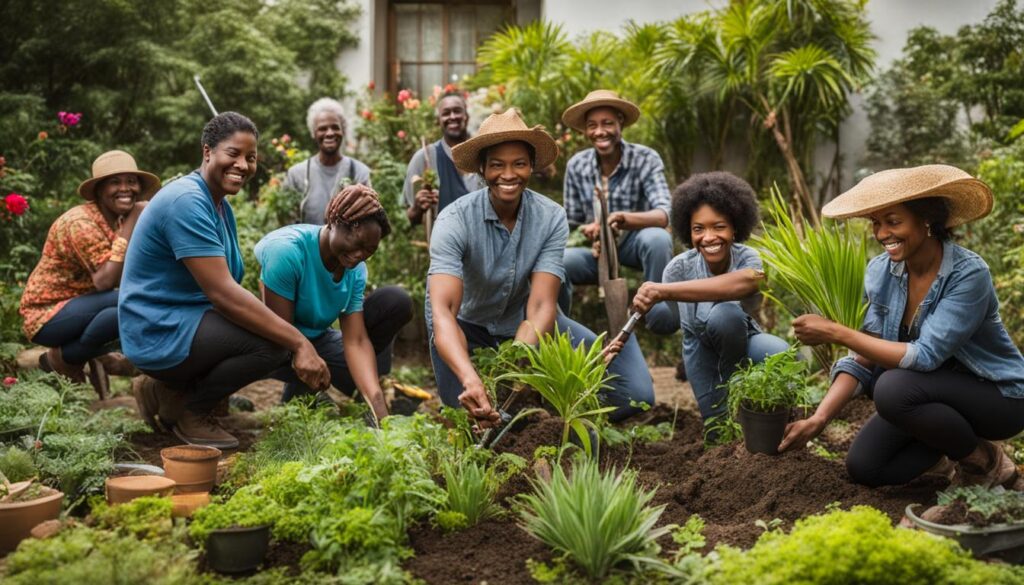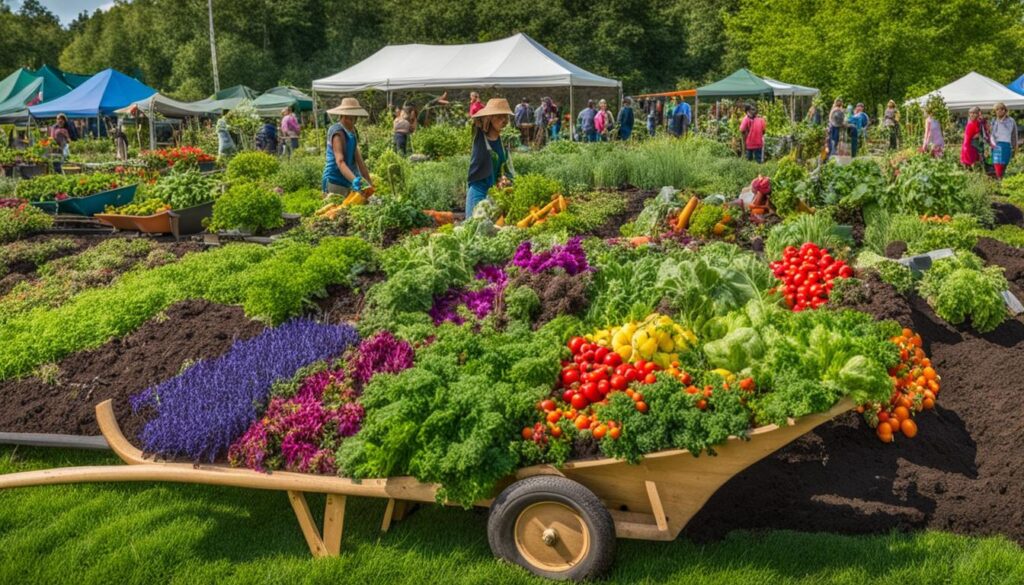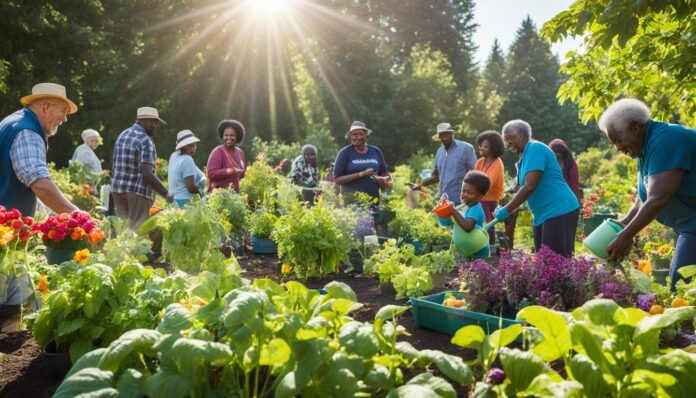Community gardening is a powerful movement that brings people together to create and nurture green spaces in their neighborhoods. It is a way for individuals of all backgrounds to connect with nature, promote sustainability, and foster a sense of community. Whether you are an experienced gardener or someone who has never picked up a trowel, community gardening offers a space where everyone can contribute and cultivate green spaces together.
Established in 1978, NYC Parks GreenThumb is the largest urban gardening program in the nation, supporting over 550 community gardens in New York City alone. Through their efforts, these gardens have become thriving hubs of activity, education, and fresh produce. Organizations like Green Guerillas and Bronx Green-Up are also making significant contributions by addressing issues of food justice and urban agriculture through community gardening initiatives.
Key Takeaways:
- Community gardening brings people together to create and nurture green spaces in their neighborhoods.
- NYC Parks GreenThumb is the largest urban gardening program in the nation, supporting over 550 community gardens in New York City.
- Community gardening promotes sustainability, fosters social connections, and addresses food justice issues.
- Green Guerillas and Bronx Green-Up are organizations making significant contributions to community gardening efforts.
- Whether you are an experienced gardener or a beginner, community gardening provides an opportunity to contribute to the well-being of yourself, your community, and the environment.
The Benefits of Community Gardening
Community gardening offers a range of benefits for individuals and communities. It provides access to fresh, healthy food and promotes sustainable practices, contributing to a greener and more environmentally friendly society.
Access to Fresh, Healthy Food
One of the significant advantages of community gardening is the access to fresh, locally grown produce. By cultivating their own fruits, vegetables, and herbs, community gardeners can enjoy the taste and nutritional benefits of freshly harvested food. This promotes a healthier diet and helps support food security in the community.
Promotes Sustainable Practices
Engaging in community gardening also promotes sustainable practices that benefit the environment. Gardeners often use organic gardening methods, avoiding harmful pesticides and fertilizers. They focus on composting and other recycling techniques that reduce waste and promote soil health. Community gardens contribute to the conservation of biodiversity by providing habitats for pollinators and other beneficial insects.
Fosters Connections and a Sense of Belonging
Community gardens serve as gathering spaces for neighbors, creating opportunities for social interaction and fostering a sense of belonging. Gardeners can share their knowledge and experiences, exchange gardening tips, and build relationships with like-minded individuals. These connections strengthen community bonds and contribute to a vibrant and supportive neighborhood.
Improves Mental and Physical Well-being
Engaging in community gardening has positive impacts on mental and physical well-being. Spending time outdoors, connecting with nature, and engaging in physical activity while gardening can reduce stress, improve mood, and enhance overall mental well-being. It also provides a low-impact form of exercise, promoting physical health and fitness.
Opportunities for Learning and Skill-building
Community gardening offers opportunities for learning and skill-building. Novice gardeners can acquire valuable knowledge about plant cultivation, soil health, and pest management from experienced gardeners. Workshops and educational programs organized by community gardening organizations provide further learning opportunities, allowing individuals to develop new skills and deepen their understanding of sustainable agriculture.
By participating in community gardening, individuals and communities can reap these benefits while creating beautiful green spaces that enhance the quality of life for all.
- “Health benefits of community gardening.” National Institute of Health.
- “Benefits of community gardening.” American Community Gardening Association.
- “Community gardens and their social impacts.” SAGE Journals.
How to Get Involved in Community Gardening
If you’re interested in community gardening, getting involved is both easy and accessible for everyone. By joining a community garden, you can contribute to the maintenance and development of green spaces, participate in workshops and activities, and connect with fellow gardeners. Here’s how you can get started:
- Find a Community Garden: Start by finding a community garden near you. You can do this by using online maps or reaching out to local gardening organizations. Take a look at the gardens in your area and choose one that aligns with your interests and location.
- Reach Out: Once you’ve identified a community garden of interest, reach out to the garden organizers or local gardening organizations. Inquire about volunteer opportunities or membership options. Many community gardens welcome volunteers who are willing to help with various gardening tasks.
- Contribute and Learn: By joining a community garden, you can actively contribute to its maintenance and development. Participate in regular gardening activities, such as planting, weeding, and harvesting, to help nurture the green space. Additionally, take advantage of workshops and educational opportunities offered by the community garden, where you can learn valuable gardening techniques and skills.
- Connect with Fellow Gardeners: Community gardening is not only about gardening; it’s also about building relationships and fostering a sense of community. Engage with fellow gardeners, share gardening tips, and exchange ideas. Building connections with like-minded individuals can enhance your gardening experience and create a supportive network.
Getting involved in community gardening is a rewarding experience that allows you to contribute to the well-being of yourself, your community, and the environment. Start exploring community gardens near you and embark on a journey of growth, learning, and connection.

The Impact of Community Gardening
Community gardening has a significant impact on individuals, communities, and the environment. Through the cultivation of green spaces and the collaborative efforts of gardeners, community gardening brings about positive change in multiple aspects of society.
Improved Quality of Life
One of the key benefits of community gardening is the increased access to fresh produce. By growing their own fruits, vegetables, and herbs, individuals can enjoy a sustainable source of nutritious food. This not only contributes to healthier diets but also reduces reliance on processed and heavily packaged foods.
Furthermore, community gardens enhance green spaces within neighborhoods, creating beautiful and tranquil environments. These are often seen as oases in urban areas, providing opportunities for relaxation, contemplation, and recreation. The presence of well-maintained and vibrant community gardens can also boost neighborhood pride and overall satisfaction.
Social Connections and Food Justice
Community gardens serve as meeting places for individuals with a shared interest in gardening and sustainable practices. The collaborative nature of community gardening fosters social connections, cooperation, and a sense of belonging. Gardeners can exchange knowledge, learn from one another, and develop friendships, creating a stronger sense of community.
Moreover, community gardening can contribute to food justice by addressing food insecurity and inequality. By sharing the harvest among garden members or through donations to local food pantries, community gardens play a significant role in providing fresh and healthy food to underserved populations. This helps to alleviate the challenge of food deserts and ensure that all individuals have access to nutritious options.
Sustainable Agriculture and Environmental Benefits
Community gardening promotes sustainable practices that minimize the impact on the environment. Gardeners often employ organic gardening methods, avoiding the use of harmful chemicals and pesticides. This helps to protect soil health, water quality, and overall ecological balance.
Furthermore, community gardens contribute to combating the urban heat island effect. The presence of green spaces helps to lower temperatures and mitigate heat-related issues in urban areas. By reducing heat absorption and increasing the cooling effect, community gardens contribute to a more pleasant and livable environment for all.
Additionally, community gardens support biodiversity by providing habitats for local plant and animal species. These green spaces attract pollinators, such as bees and butterflies, which are crucial for the reproduction of plants and the overall health of ecosystems.
| Impact of Community Gardening | Description |
|---|---|
| Improved Quality of Life | Increased access to fresh produce, enhanced green spaces, and neighborhood pride |
| Social Connections and Food Justice | Fostering social connections, knowledge exchange, and addressing food inequality |
| Sustainable Agriculture and Environmental Benefits | Promoting organic gardening, combating urban heat islands, and supporting biodiversity |
Tips for Successful Community Gardening
To ensure successful community gardening, it is crucial to plan and communicate effectively with fellow gardeners. By following these essential tips, you can create a harmonious and productive community garden:
- Establish a Clear Vision and Goals: Define a shared vision for the garden and set achievable goals. This will help guide your efforts and keep everyone on the same page.
- Organize Regular Meetings: Schedule regular meetings to discuss garden progress, address any concerns, and make collaborative decisions. This promotes teamwork and keeps everyone engaged.
- Assign Tasks: Assign specific tasks to different members based on their skills and interests. This ensures that garden maintenance and care responsibilities are distributed equitably.
- Consider Everyone’s Needs and Preferences: Take into account the diverse needs and preferences of all garden members. This includes factors like plant selection, garden layout, and accessibility to create an inclusive and enjoyable gardening experience for everyone.
- Practice Sustainable Gardening Techniques: Adopt sustainable gardening practices such as composting, organic pest control, and water conservation. This helps protect the environment and ensures the long-term health of the garden.
- Maintain Open Communication: Encourage open and transparent communication among garden members. This fosters a supportive environment where ideas, suggestions, and challenges can be shared and addressed.
Expert Insight:
“Successful community gardening relies on effective communication and collaboration. By working together and considering the needs of all garden members, you can create a thriving and sustainable green space.”
– Diana Martinez, Community Gardening Expert
By implementing these tips, you can maximize the potential of your community garden and create a flourishing green space that benefits everyone involved.
Resources for Community Gardeners
As a community gardener, I understand the importance of accessing resources that can help enhance my gardening journey. Fortunately, there are several organizations that provide valuable support and guidance to community gardeners like myself.
NYC Parks GreenThumb
Website: https://www.greenthumb.nycgovparks.org/
NYC Parks GreenThumb is a renowned organization that offers a wide range of resources for community gardeners in New York City. They provide workshops and educational materials to help gardeners develop their skills and knowledge. Whether you’re a beginner or an experienced gardener, GreenThumb offers valuable advice and guidance to ensure the success of your community garden.
Green Guerillas
Website: https://www.greenguerillas.org/
Green Guerillas is an organization dedicated to empowering communities through urban gardening. They offer resources such as organizing support, advocacy, and educational materials to help community gardeners address food justice and urban agriculture issues. Green Guerillas is committed to providing the necessary tools and knowledge for community gardeners to create sustainable and thriving green spaces.
| Organization | Website |
|---|---|
| NYC Parks GreenThumb | https://www.greenthumb.nycgovparks.org/ |
| Green Guerillas | https://www.greenguerillas.org/ |
Bronx Green-Up
Website: https://www.nybg.org/community-gardening/bronx-green-up/
Bronx Green-Up is an initiative of the New York Botanical Garden that focuses on transforming vacant lots into vibrant green spaces. They offer resources, training, and technical assistance to community gardeners in the Bronx. By providing access to tools, seeds, and plants, Bronx Green-Up empowers community gardeners to create and maintain thriving gardens that foster community pride.
These organizations are just a few examples of the many resources available to community gardeners. From workshops and educational materials to access to tools and plants, these resources play a crucial role in supporting the success of community gardens.

Community Gardening Success Stories
Community gardening has sparked numerous success stories across the United States. These stories serve as powerful examples of how community gardens can transform abandoned spaces into vibrant green oases that benefit both individuals and communities.
Transforming Abandoned Lots
One inspiring success story comes from the city of Detroit, where urban decay and vacant lots were a common sight. Through community gardening initiatives, local residents have come together to reclaim these abandoned spaces and turn them into thriving community gardens. These gardens not only beautify the neighborhoods but also provide fresh produce and a sense of pride for the community.
Improving Food Security
In New Orleans, community gardens have played a crucial role in improving food security in underserved areas. By growing their own fruits and vegetables, residents have gained access to fresh, healthy food that was previously scarce. These gardens have empowered the community to take control of their food sources and ensure their families’ well-being.
“Community gardens give people the chance to connect with the earth and take ownership of their health.” – Jane, a community gardener in New Orleans
Fostering Community Pride
In the city of Chicago, community gardens have become symbols of neighborhood pride and unity. By coming together to create and maintain these green spaces, residents have formed strong bonds and a shared sense of purpose. The gardens have become gathering places for community events and activities, bringing people from different backgrounds together.
Creating Sustainable and Inclusive Communities
One of the greatest achievements of community gardening is its ability to create sustainable and inclusive communities. City rooftops have been transformed into vibrant urban gardens, contributing to local food production and reducing the carbon footprint. Additionally, community gardens have provided opportunities for individuals from diverse backgrounds to come together and work towards a common goal, fostering inclusivity and understanding.
These success stories highlight the power of collaboration, resilience, and the potential impact of community gardening. By sharing their experiences, these communities inspire others to cultivate green spaces and create positive change.
Conclusion
Community gardening offers a multitude of benefits, bringing people together to cultivate green spaces and foster connections. Whether you are an experienced gardener or a beginner, community gardening provides an opportunity to contribute to the well-being of yourself, your community, and the environment. By embracing community gardening, we can create a more sustainable and inclusive future for all.
By participating in community gardening, you can have a direct impact on the quality of local food sources. Community gardens offer access to fresh, organic produce, promoting healthier eating habits and improving overall nutrition. Additionally, community gardens serve as educational spaces, where individuals can learn about sustainable gardening practices and the importance of biodiversity.
Beyond the individual benefits, community gardening strengthens social bonds and fosters a sense of belonging within neighborhoods. Working together towards a shared goal creates opportunities for collaboration, knowledge sharing, and community engagement. These green spaces become hubs for social interaction, where friendships are formed, and cultural exchanges take place.
In conclusion, community gardening is a transformative movement that allows individuals to connect with nature, contribute to their communities, and create positive change. By embracing community gardening, we can build healthier, more resilient communities while nurturing the environment. So, grab your gardening tools, join a community garden, and be part of the growing movement towards a greener, more inclusive future.
FAQ
What is community gardening?
Community gardening is a movement that brings people together to create and nurture green spaces in their neighborhoods. It involves individuals coming together to cultivate and maintain a shared garden for the benefit of the community.
Why should I get involved in community gardening?
Community gardening offers a range of benefits, including access to fresh, healthy food, opportunities for learning and skill-building, improved mental and physical well-being, and the chance to connect with fellow gardeners and neighbors. It also promotes sustainability and creates a sense of belonging within the community.
How can I get involved in community gardening?
To get involved in community gardening, you can start by finding a community garden near you through online maps or by reaching out to local gardening organizations. Many community gardens welcome volunteers and offer membership opportunities. By joining a community garden, you can contribute to the maintenance and development of the green space and participate in workshops and activities.
What impact does community gardening have?
Community gardening has a significant impact on individuals, communities, and the environment. It improves access to fresh produce, enhances green spaces, fosters social connections, promotes sustainable agriculture practices, beautifies neighborhoods, combats urban heat islands, and supports biodiversity.
How can I ensure success in community gardening?
To ensure success in community gardening, it is important to plan and communicate effectively with other gardeners. Establishing a clear vision and goals for the garden, organizing regular meetings, and assigning tasks can help maintain a harmonious and productive community garden. It is also essential to consider the needs and preferences of all garden members, practice sustainable gardening techniques, and maintain open communication.
What resources are available for community gardeners?
There are various resources available for community gardeners. Organizations like NYC Parks GreenThumb, Green Guerillas, and Bronx Green-Up provide workshops, educational materials, and gardening advice. They also offer access to tools, seeds, and plants, helping community gardeners enhance their gardening skills and create thriving green spaces.
Are there any success stories related to community gardening?
Yes, community gardening has sparked numerous success stories across the United States. From transforming abandoned lots into vibrant green spaces to improving food security and fostering community pride, community gardens have made a positive impact in many neighborhoods. These success stories demonstrate the power of collaboration, resilience, and the ability of community gardening to create sustainable and inclusive communities.

